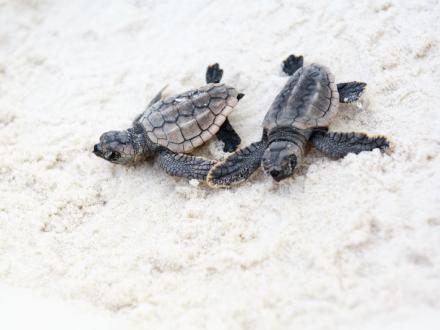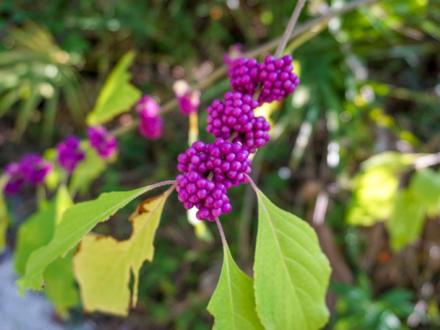
It’s a Wild Life at Bon Secour National Wildlife Refuge
This is part two in a series of three blogs on the Bon Secour National Wildlife Refuge in Gulf Shores. Read part one.
The Bon Secour National Wildlife Refuge is a popular place for people to connect with the coast - but that’s not its only purpose. True to its name (which is French for “safe harbor”), the refuge was founded to provide a sanctuary for various types of flora and fauna, many of which are on the threatened or endangered species list.
Designated as one of the 10 Natural Wonders of Alabama, the refuge offers visitors the chance to encounter native plants and animals surviving - and thriving - in their natural habitat. From the safety of four terrific trails, you’ll find many forms of flora and fauna you’ve never seen before - and are unlikely to see anywhere else.

Fauna
Lions, tigers, and bears, oh my! While you won’t find any of those roaming through the refuge, you’ll find many equally exciting wildlife residents. Alligators, red fox, armadillos, and even bobcats are familiar sights on any trip down the trails. Unlike a zoo, the wildlife is free to roam as they please, so be sure to keep your distance.
If you’re lucky, you may also catch a glimpse of some not-so-common creatures. The refuge is home to endangered species that depend on its protection for survival and recovery. Many of these species are shy and seasonal, making them even more special to spot.
When you visit, tread quietly and keep your eyes peeled for some of these wonderful wildlife residents.
Alabama Beach Mouse
It’s rare to see this nocturnal dune dweller, but you’ll know it’s there by tiny tracks among the soaring sand dunes. The Alabama Beach Mouse plays an important role in maintaining our dune communities, but much of its habitat has been destroyed by coastal development. In fact, the refuge protects their only remaining undisturbed habitat in the state. When traveling the Pine Beach Trail, be sure to stay on the marked path and away from the dunes.
Sea Turtles
If you visit from May to October, you may spot sea turtles nesting on the refuge shores. The beaches are a haven for various sea turtles during nesting season, including Loggerhead, Green, and Kemp’s Ridley turtles. Staff and Share the Beach volunteers protect and monitor the eggs during incubation, then see the newborn turtles safely to the surf. These species are in decline worldwide, and the refuge is an important step in sea turtle recovery. Please do not touch or disturb sea turtle nests, hatchlings, or tracks.
Birds
The bird is the word at Bon Secour National Wildlife Refuge. The refuge is home to more than 360 species of birds, from warblers to waterfowl to woodpeckers and more. The best time for birding is spring and fall when the refuge acts as an important stopover and staging habitat for hundreds of migratory songbirds. You’ll find feathered friends along every trail, so don’t forget to grab your binoculars and handy bird booklet.
You’re sure to see many spectacular species, including:
- Snowy Plover
- Osprey
- Great Blue Heron
- Red-bellied Woodpecker
- Carolina Wren
- Northern Cardinal
- Belted Kingfisher
- Peregrine Falcon

Flora
Animals aren’t the only wild residents that plant their roots here. Almost 7,000 acres of diverse coastal wilderness provide plenty of places for plant life, and the refuge has some fantastic flora. Whether you enjoy colorful blooms, delicate foliage, or towering trees, you’ll find some of everything along the trails.
As you explore the lush maritime forest, wander through the wetlands, and stroll near the dune swales, interpretive signs, and handy guidebooks will point out the unique plants that live in each landscape.
Trees
If trees are your thing, you’re really in for a tree-t. You’ll find dozens of unique tree species across the refuge, including live oaks, southern magnolias, longleaf pines, bald cypress, Atlantic white cedar, and many others. In areas of maritime forest, they all come together under a dense canopy draped in thick Spanish moss.
Blooms and Berries
Flowering plants and shrubs provide a splash of color as well as seasonal snacks for birds, squirrels, and other refuge wildlife. Some of the most common species include blueberries, wild olive, muscadine, saw palmetto, Yaupon, Conradina, and Persimmon.
Coastal Scrub
Between the maritime forests and sandy shores lies a living ecosystem all its own. As ocean winds and salty spray blow in from the coast, they create a twisted sculpture of hardy shrubs and low-lying trees that provides shelter for wildlife and protects inland areas. You may spot sand pine, sand live oak, myrtle-leaved oak, and Florida rosemary, among others.
Sea Oats
As you approach the frontal dunes, keep your eyes peeled for swaying stalks of sea oats. These native coastal plants keep the dunes intact and provide a tasty meal for the Alabama Beach Mouse.
